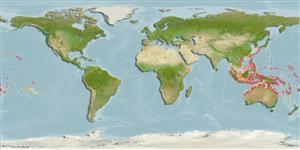Common names from other countries
>
Eupercaria/misc (Various families in series Eupercaria) >
Labridae (Wrasses) > Corinae
Etymology: Halichoeres: Greek, als, alis = salt + Greek, choiros = pig (Ref. 45335).
More on authors: Quoy & Gaimard.
Environment: milieu / climate zone / depth range / distribution range
Οικολογία
Θαλασσινό(ά) Υφαλόφιλο(α); εύρος βάθους 2 - 30 m (Ref. 48636), usually 2 - 18 m (Ref. 89972). Tropical; 30°N - 32°S
Indo-Pacific: Christmas Island and Rowly Shoals in the eastern Indian Ocean to the Line and Ducie islands, north to south Japan, south to Lord Howe Island.
Μέγεθος / Βάρος / Age
Maturity: Lm ? range ? - ? cm
Max length : 27.0 cm TL αρσενικό/απροσδιόριστο; (Ref. 9710)
Short description
Κλείδες προσδιορισμού | Μορφολογία | Μορφομετρία
Ραχιαίες άκανθες (συνολικά) : 9; Μαλακές ραχιαίες ακτίνες (συνολικά) : 11; Εδρικές άκανθες: 3; Μαλακές εδρικές ακτίνες: 10 - 11. Light greenish to yellowish on back, white below; scale rims pink to blackish; a black spot is at the upper base of the pectoral fin; another black spot about equal to eye diameter is at the upper base of the caudal peduncle.
Inhabits sandy areas of reef flats, lagoons, and semi-protected seaward reefs. Juveniles shallow in protected coastal waters; adults to about 30 m depth (Ref. 48636). Feeds on sand and rubble dwelling invertebrates (crustaceans, mollusks, forams, polychaetes, fish eggs, and small fishes). Has the habit of following sand-disturbing fishes such as goatfishes in order to intercept escaping prey. Minimum depth reported taken from Ref. 30874.
Life cycle and mating behavior
Maturities | Αναπαραγωγή | Spawnings | Egg(s) | Fecundities | Προνύμφες
Bi-directional sex change has been confirmed for this species (Ref. 103751). Distinct pairing during breeding (Ref. 205).
Randall, J.E., G.R. Allen and R.C. Steene, 1990. Fishes of the Great Barrier Reef and Coral Sea. University of Hawaii Press, Honolulu, Hawaii. 506 p. (Ref. 2334)
IUCN Red List Status (Ref. 130435)
CITES (Ref. 128078)
Not Evaluated
Threat to humans
Harmless
Human uses
αλιεία: Εμπορικό(ά); Ενυδρείο: Εμπορικό(ά)
Εργαλεία
Special reports
Download XML
Διαδικτυακές πηγές
Estimates based on models
Preferred temperature (Ref.
115969): 24.7 - 29.3, mean 28.4 (based on 2136 cells).
Phylogenetic diversity index (Ref.
82804): PD
50 = 0.5000 [Uniqueness, from 0.5 = low to 2.0 = high].
Bayesian length-weight: a=0.01000 (0.00623 - 0.01606), b=3.00 (2.87 - 3.13), in cm Total Length, based on LWR estimates for this species & Genus-body shape (Ref.
93245).
Τροφικό Επίπεδο (Ref.
69278): 3.5 ±0.51 se; based on food items.
Ελαστικότητα (Ref.
120179): Μεσαίο(α), ελάχιστος χρόνος για διπλασιασμό πληθυσμού 1,4 - 4,4 έτη (Preliminary K or Fecundity.).
Fishing Vulnerability (Ref.
59153): Low vulnerability (17 of 100).
